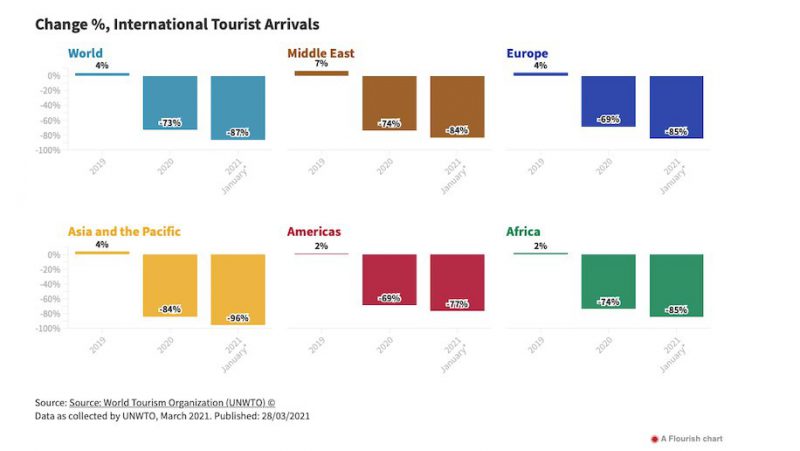UNWTO Cites 87 Percent Drop in Tourism in 2021
As global tourism continues to suffer setbacks, possible recovery projected starting in Q3
March 31, 2021

The World Tourism Organization (UNWTO) has revealed that global tourism has suffered further setbacks in 2021, with an 87 per cent fall in international tourist arrivals in January.
The latest edition of the UNWTO World Tourism Barometer shows that all regions around the world experienced large drops in tourist arrivals in January compared to the year before, citing “mandatory testing, quarantines, and in some cases the complete closure of borders” as obstacles to the resumption of international travel. The report also highlights the delay of the vaccine roll-out as a factor.
The report shows that the Asia-Pacific region recorded the largest decrease in international arrivals (-96 percent) in the first month of the year due to its high levels of travel restrictions still in place. Europe and Africa saw a decline of 85 percent in arrivals, while the Middle East followed closely behind with a drop of 84 percent.
Meanwhile, the Americas saw a decrease of 79 percent in spite of better results in the last quarter of 2020.
Based on current trends, the organization forecasts that international tourist arrivals will be down by about 85 percent in the first quarter of this year, representing a loss of 260 million international arrivals when compared to pre-pandemic levels.
The UNWTO is therefore continuing its calls for a “stronger coordination on travel protocols between countries to ensure the safe restart of tourism and avoid another year of massive losses for the sector.”
Looking ahead, the organization has released two scenarios for 2021 which take into account a possible recovery in international travel in the second half of the year.
The first scenario forecasts a rebound in July, resulting in a 65 percent increase in arrivals in comparison to 2020, though this remains 55 percent lower than 2019 levels. The second scenario points to a recovery in September, with a 30 percent increase in arrivals compared to last year – this would be 67 percent below the levels of 2019.
Both of these are dependent on a “major lifting of travel restrictions, the success of vaccination programs or the introduction of harmonized protocols such as the Digital Green Certificate planned by the European Commission.” Indeed, the organization called on Europe to set a global example by restarting the sector earlier this week.
“2020 was the worst year on record for tourism,” said UNWTO Secretary-General Zurab Pololikashvili. “The international community needs to take strong and urgent action to ensure a brighter 2021. Many millions of livelihoods and businesses are depending on it. Improved coordination between countries and harmonized travel and health protocols are essential to restore confidence in tourism and allow international travel to resume safely ahead of the peak summer season in the northern hemisphere.”
Destinations Off Limits to Overseas Visitors
Among the destinations currently off limits, more than half of them have been inaccessible to overseas travelers since April of last year. Most of the former tourist draws affected are in Asia, the Pacific and Europe, according to the UNWTO Travel Restrictions Report.
On the other side of the coin, more than a third of global tourism destinations are now partially open to international visitors, with Albania, Costa Rica, Dominican Republic, North Macedonia and Tanzania, lifting all COVID-19 related travel restrictions.
Noting that travel restrictions have been widely used to restrict the spread of the virus, Pololikashvili stressed that “as we work to restart tourism, we must recognize that restrictions are just one part of the solution.” He further underscored that travel restrictions must be based on the latest data and analysis, and consistently reviewed “so as to allow for the safe and responsible restart of a sector upon which many millions of businesses and jobs depend.”
Testing and Quarantining
The report shows a growing trend in international destinations “adopting a more nuanced, evidence- and risk-based approach” to coronavirus linked travel restrictions. More countries are requiring tourists to present a negative Polymerase Chain Reaction (PCR) or COVID-19 antigen test for entry, as well as providing contact details for tracing purposes. Some 30 percent of all worldwide destinations have made presenting negative test results their main requirement for entry.
Remaining Cautious
According to UNWTO, many governments have advised their citizens to avoid non-essential travel abroad. Governments of the world’s top ten in-bound destinations, receiving some 44 percent of all international tourists worldwide, have adopted that policy, according to figures from March 2018. How these destinations review policies in the light of the pandemic will play a critical role in restarting and restoring global tourist flows in the months ahead, said the report.





